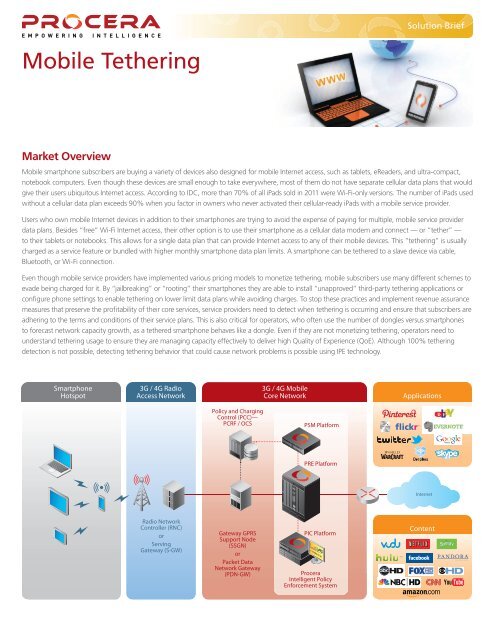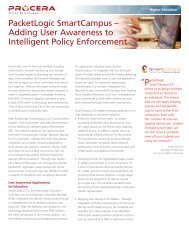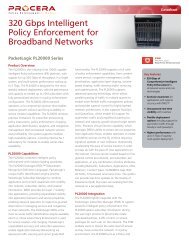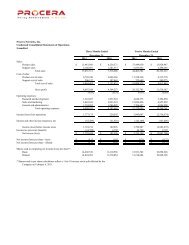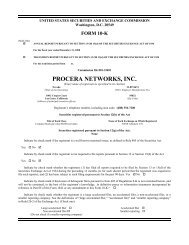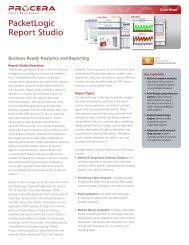Mobile Tethering
Mobile Tethering - Procera Networks
Mobile Tethering - Procera Networks
Create successful ePaper yourself
Turn your PDF publications into a flip-book with our unique Google optimized e-Paper software.
10864208106420Solution Brief<strong>Mobile</strong> <strong>Tethering</strong>Market Overview<strong>Mobile</strong> smartphone subscribers are buying a variety of devices also designed for mobile Internet access, such as tablets, eReaders, and ultra-compact,notebook computers. Even though these devices are small enough to take everywhere, most of them do not have separate cellular data plans that wouldgive their users ubiquitous Internet access. According to IDC, more than 70% of all iPads sold in 2011 were Wi-Fi-only versions. The number of iPads usedwithout a cellular data plan exceeds 90% when you factor in owners who never activated their cellular-ready iPads with a mobile service provider.Users who own mobile Internet devices in addition to their smartphones are trying to avoid the expense of paying for multiple, mobile service providerdata plans. Besides “free” Wi-Fi Internet access, their other option is to use their smartphone as a cellular data modem and connect — or “tether” —to their tablets or notebooks. This allows for a single data plan that can provide Internet access to any of their mobile devices. This “tethering” is usuallycharged as a service feature or bundled with higher monthly smartphone data plan limits. A smartphone can be tethered to a slave device via cable,Bluetooth, or Wi-Fi connection.Even though mobile service providers have implemented various pricing models to monetize tethering, mobile subscribers use many different schemes toevade being charged for it. By “jailbreaking” or “rooting” their smartphones they are able to install “unapproved” third-party tethering applications orconfigure phone settings to enable tethering on lower limit data plans while avoiding charges. To stop these practices and implement revenue assurancemeasures that preserve the profitability of their core services, service providers need to detect when tethering is occurring and ensure that subscribers areadhering to the terms and conditions of their service plans. This is also critical for operators, who often use the number of dongles versus smartphonesto forecast network capacity growth, as a tethered smartphone behaves like a dongle. Even if they are not monetizing tethering, operators need tounderstand tethering usage to ensure they are managing capacity effectively to deliver high Quality of Experience (QoE). Although 100% tetheringdetection is not possible, detecting tethering behavior that could cause network problems is possible using IPE technology.SmartphoneHotspot3G / 4G RadioAccess Network3G / 4G <strong>Mobile</strong>Core NetworkApplicationsPolicy and ChargingControl (PCC)—PCRF / OCSPSM PlatformPRE PlatformInternetRadio NetworkController (RNC)orServingGateway (S-GW)Gateway GPRSSupport Node(SSGN)orPacket DataNetwork Gateway(PDN-GW)PIC PlatformProceraIntelligent PolicyEnforcement SystemContent
Market DynamicsThere are several key dynamics impacting the market for tethering services:Accelerating demand for mobile Internet devices in all formfactors — IDC forecasts worldwide shipments in 2012 of more than 600million smartphones and 100 million tablets, 90% of which are Appleand Android-based tablets. By 2016, IDC expects global shipments ofsmartphones and tablets to double, reaching over 1.2 billion units and 200million units, respectively. Smartphones are experiencing high growth dueto their versatility and ever increasing applications, including rapid adoptionof mobile messaging and social networking, falling prices, faster 3G and4G networks, increasing price competition among service providers,and the ability of mobile device operating systems to handle newer andfaster hardware. Tablets are coming on strong because they offer a morecompelling user experience than PCs, to the point wherethey are starting to replace laptop computers.Surging use of hotspot-capable smartphones across 3G and4G markets — Wi-Fi capable smartphones represented 95% of totalsmartphone sales in 2011 according toStrategy Analytics. This gives smartphonesthe capability to tether to multiple devicesat the same time, creating a personal Wi-Fihotspot. Strategy Analytics forecasts growthin sales of mobile hotspot handsets willexceed 400% between 2011 and 2016. Thiscapability is already common in Android4G LTE smartphones and support for it isexpected in the next iPhone. Hotspot-capablesmartphones will become the preferred wayto tether as this capability becomes ubiquitous.Adoption of higher limit, 4G LTE data plans — Data service plans onLTE networks are currently following the pricing models established in 3Gnetworks. The plans are tiered by monthly data limits, currently rangingfrom 1GB to 10 GB in the U.S. and Asia and up to 30GB in Europe, withdata speeds often throttled and overcharges assessed at different dataincrements and pricing.To stop these practices andimplement revenue assurancemeasures that preserve theprofitability of their core services,service providers need to detectwhen tethering is occurring ...Unrestricted or unauthorized tethering will continue to strainmobile operator networks — With 4G data speeds and data planlimits increasing, mobile subscribers are more likely to take advantageof tethering to maximize use of their plan limits. Service provider 3UK isalready reporting that 10% of its network traffic is from tethering andcontinues to grow in popularity. In order to stop revenue and profitabilityerosion, service providers need to manage tethering usage. Preventingunauthorized tethering or putting limits on authorized tethering is the onlyway to prevent excessive, unplanned network usage.Solution Needs<strong>Mobile</strong> operators looking to manage and monetize mobile tethering facesome fundamental questions:• Is unauthorized tethering occurring in their network?• How much data are authorized tethering subscribers using?• Which devices are their subscribers tethering?• Must tethering limits be imposed even in the context ofunlimited data plans?• How are tethering features monetized as part of aservice bundle?As they execute their plans for managing and monetizing tethering,mobile operators must consider three key success factors.Awareness of what is happening in their network is the first step tounderstanding tethering usage in their network. Initially, service planningshould be centered around subscriber, device, location, and applicationawareness in the mobile operator’s network, helping the marketing teamunderstand tethering usage characteristics andpatterns that can help them define how existingplans can include tethering. For service providersthat have previously allowed “free” tethering,heightened awareness is critical since subscribersmay resort to using unauthorized tetheringschemes to avoid paying fees.Blocking tethering, whether or not it is permittedby the subscriber service plan agreement, iskey to protecting mobile operator revenue andprofitability. Highly accurate tethering detection is key to enforcing blockingpolicies. This ensures that authorized tethering is readily distinguished fromunauthorized use, minimizing red flags issued for legitimate subscribertethering, especially when it causes excessive network usage.Monetization of tethering services can be a significant revenueopportunity for mobile service providers but it requires flexible service planimplementation to provide subscriber value. <strong>Tethering</strong> is typically offered asa feature bundled with a data service plan, a feature add-on to an existingplan, or as a stand-alone service. But many variations on these pricingmodels are possible. A subscriber’s unlimited data plan service could bemodified to allow tethering with a specific monthly tethering limit, throttlebandwidth under certain conditions, or restrict tethering usage to specificdays and/or times. When unauthorized tethering usage is detected, serviceproviders could also implement an up-sell strategy. In this scenario thesubscriber is warned, then directed to a captive portal that allows them to“legitimize” by selecting a service upgrade.
The Procera SolutionProcera’s products have been deployed in some of the world’s largestmobile operator networks to monitor, manage or monetize networktraffic while attaining industry-leading scalability and reliability.Three platform types perform various software functions that, whenconfigured together, operate as an Intelligent Policy Enforcement (IPE)system:• PacketLogic Real-Time Enforcer (PRE)• PacketLogic Intelligence Center (PIC)• PacketLogic Subscriber Manager (PSM)These platforms interact with various CDMA, 3G UMTS, and 4G LTEmobile network elements to provide policy enforcement. Together,they help mobile operators address the three key success factors formanaging and monetizing mobile tethering.AwarenessThe PSM is the main component in establishing tethering usagepolicies. It does this by connecting with 3GPP mobile network Policyand Charging Control (PCC) components — the Policy and ChargingRules Function (PCRF), Online Charging System (OCS), and OfflineCharging System (OFCS) — to establish subscriber awareness in themobile operator’s network. <strong>Tethering</strong> awareness properties can includesubscriber (IMSI) and device (IMEI) identification, location (ULI), serviceplan information, and subscriber session connectivity with networkelements such as the GGSN, S-GW, and PDN-GW. <strong>Tethering</strong> detectionis session based, allowing for detection every time the subscriber initiatesa new PDP context later. This mechanism allows the subscriber to restarttheir phone to receive a new PDP context and continue using authorizeddata services.BlockingThe PSM feeds the subscriber policies provisioned to the PRE platform toenforce policies that detect tethering and redirect customers to a portalto purchase a tethering plan, or block it if the user continues to violatethe Terms of Service. <strong>Tethering</strong> policies are enforced by the PRE throughProcera’s industry-leading DRDL technology. The system can also detectillicit modem when a mobile subscriber takes a SIM card provided withan authorized mobile device and inserts it into a modem or dongle totether with a laptop or a PC. <strong>Tethering</strong> usage reports can be used toidentify subscribers that may be tethering without a service plan and helpservice providers assess network impacts, aiding capacity planning.MonetizationThe PSM integrates tightly with PCC components to enable monetizationof authorized tethering services. Many tethering service personalizationsare possible with Procera’s IPE system, including:• Offer tethering as part of an existing data plan withseparate data limits• Offer tethering as a stand-alone plan• Direct subscribers engaged in unauthorized tethering to acaptive portal to choose from legitimate tethering options• Time-of-day based tethering• Limit tethering bandwidth at specific data plans limitsAll tethering statistics generated by the PRE platform can be visualized inreal time or sent to the PIC platform for further reporting and analysis,using Report Studio, to support business planning.
Solution BriefAbout ProceraProcera Networks delivers Intelligent Policy Enforcement (IPE) solutions for network operators, that leverageindustry-leading Deep Packet Inspection (DPI) technology. Procera’s PacketLogic solutions are also used to deliverhigh performance, scalable Application Delivery Networking deployments for network operators. Our technologyenables carriers, broadband providers and higher education institutions to improve the quality and longevity oftheir networks, better monetize their infrastructure investments, control security hazards, and create attractiveservices for their users by making qualified business decisions based on granular user and traffic intelligence. TheApplication Delivery Network capabilities of the PacketLogic solutions enable network operators to optimize theuse of their infrastructure, from the address optimization delivered by Carrier Grade NAT, to the services andserver optimization delivered by Advanced Traffic Steering.The PacketLogic Report Studio is the first Network Intelligence and Analytics solution for Intelligent PolicyEnforcement systems that provides comprehensive report creation to answer the business questions networkoperators need answered to run their business. PacketLogic Report Studio delivers print-ready reports that canbe customized to focus on complex analytics that can be used to shape investments in network infrastructure,new services marketing, and product launch decisions.PacketLogic isdeployed at morethan 700 customerswho value theunparalleledaccuracy and highendperformanceof the PacketLogicsolution.www.proceranetworks.cominfo@proceranetworks.comwww.proceranetworks.comCorporate OfficesProcera Networks, Inc.4121 Clipper CourtFremont, CA 94538P. +1 510-230-2777F. +1 510-656-1355European HeadquartersProcera NetworksBirger Svenssons Väg 28D432 40 Varberg, SwedenP. +46 (0)340-48 38 00F. +46 (0)340-48 38 28Asia/Pacific HeadquartersProcera Networks, Pte. Ltd.Penthouse #44-01, Suntec Tower Three8 Tamasek Boulevard, Singapore 038988Phone: +65 6829 2220Fax: +65 6829 2206Copyright © 2013 Procera Networks. All rights reserved. All other trademarks are property of their respective owners. SB_MoTe_Q2_2013_04_03_US


